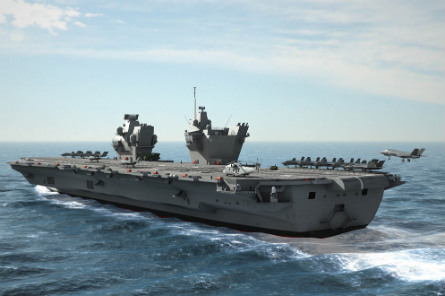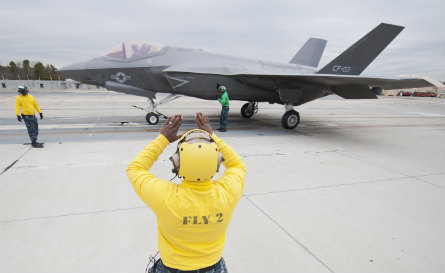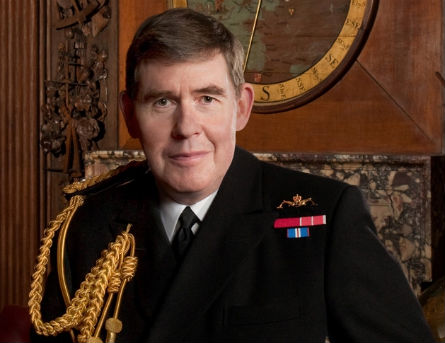The Royal Navy and Fleet Air Arm entered a period of forced transformation 16 months ago, when the UK government approved major cuts to their equipment and personnel structures as part of its Strategic Defence and Security Review (SDSR). However, with a final tranche of about 300 staff cuts having been confirmed in mid-January, the head of the UK’s "senior service" is looking firmly to the future.
While the SDSR led to the removal of the UK’s carrier strike capability, via the early retirement of its BAE Systems Harrier GR7/9s, First Sea Lord and Chief of the Naval Staff Adm Sir Mark Stanhope believes the RN remains well positioned. Reductions that have been felt since late 2010 have driven a busy agenda, "but that hasn’t disturbed or changed the effect that the navy is having out there at sea or on land", he says.
The future shape of the lapsed carrier strike capability is already taking form, with major structures for the first of two 65,000 tonne Queen Elizabeth-class vessels now in assembly and deliveries looming for the UK’s first test examples of the Lockheed Martin F-35 Joint Strike Fighter (JSF).
 |
|---|
© Aircraft Carrier Alliance |
Due to be accepted during May, short take-off and vertical landing (STOVL) aircraft BK-l and BK-2 will support the UK’s participation in US-led initial operational test and evaluation activities at Edwards AFB, California. Another should follow in 2014, with the US Marine Corps having agreed in principle to swap a C-model carrier variant for London’s originally intended third F-35B. This was requested after the UK swapped its interest to the largest version of the JSF, as part of the SDSR.
An in-service date for the F-35C will be defined as part of a Main Gate investment decision next year, although final numbers are not expected to be determined before the UK’s next defence review, planned for 2015.
The decision to jump from the STOVL version has prompted changes to the Queen Elizabeth design, with Stanhope now expecting second-of-class ship the Prince of Wales to gain an electromagnetic aircraft launch system/advanced arresting gear, for "cat and trap" operations.
 |
|---|
© Lockheed Martin The Royal Navy will draw on the personnel experience of its US counterpart to operate the F-35C |
Using the same technology developed for the US Navy’s next-generation carrier the Gerald R Ford, this will enable the carrier to support flying trials soon after becoming available. Specification changes should be finalised by the end of 2012, when the UK will also confirm the expected in-service dates for its largest ever warships. This was originally targeted for around 2020, but Stanhope notes: "The big question is what happens to the Queen Elizabeth."
The RN faces a major challenge in regaining the skills required to resume "big deck" carrier operations, after what is nearing a 40-year gap since the retirement of Ark Royal and its Blackburn Buccaneers and McDonnell Douglas Phantoms. This need will be fulfilled partly under the terms of a statement of intent recently signed by the service and its US counterpart.
The first Fleet Air Arm pilot to benefit from the arrangement is just completing a combat deployment flying Boeing F/A-18E Super Hornets from the USS John Stennis, and others will follow.
"About four more [pilots] are about to enter the system, but this will increase to the teens over the next 10 years," Stanhope says. Some Royal Air Force personnel will also be trained for carrier operations under the arrangement, while one or two RN pilots are likely to begin flying soon with the French navy.
"It’s very easy to focus on pilots, but that’s not the core of the challenge we face," Stanhope says. Other skills to be learned include providing trained air traffic controllers, landing signal officers, deck crew and weapons-handling personnel, plus the engineers to support high-tempo operations at sea.
A new airborne early warning capability is also to be acquired for the future carriers, with the RN’s Westland Sea King 7s to be retired by March 2016.
 |
|---|
© Crown Copyright |
Stanhope confirms that a capability gap could occur until the Prince of Wales becomes operational, and that although the service has studied equipping several AgustaWestland AW101 Merlins for the role, other options remain open. In the long term, the navy also has a "huge interest" in unmanned air vehicles and underwater equivalents, although its chief says “it’s just [a question of] moving forward at the right pace”.
 |
|---|
© Crown Copyright Admiral Sir Mark Stanhope has steered the navy through the SDSR process |
Describing morale within his service as "balanced", as a result of the SDSR process, Stanhope says: "It’s not a question of good or bad, but of people recognising where we are and looking forward."
Referring to the service’s participation in last year’s Libya operation, tension with Iran in the Straits of Hormuz and Argentina over the Falkland Islands, anti-piracy and counter-narcotics activities, and supporting security requirements for this year’s Olympic Games in London, he concludes: "We are a navy that is relevant to today's requirements."
Source: Flight International























